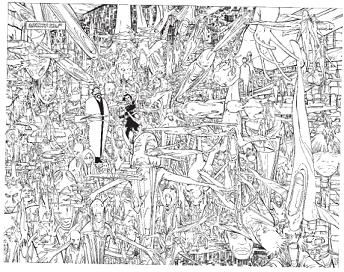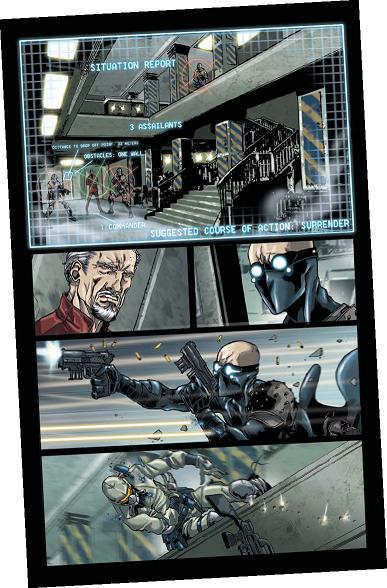
ESTABLISHING SHOTS COMMUNICATE
There are two quick reasons why I’ll stress establishing shots: First, a scene is made much clearer with one establishing shot (sometimes more than one is necessary); and second, most artists hate drawing them. I’ve been told by many artists that establishing shots are boring, so they don’t want to draw them. Yeah, okay, that may be true, but it doesn’t have to be.

Spatial Relationships Gone Mad!
In John Romita Jr.’s double-page spread establishing shot of the afterlife, the reader follows the main character, in the black suit, into the world after death. This is the reader and the lead character’s introduction, and John has established that all these people and things are moving in different directions and overcrowding each other. The laws of physics do not apply here, and this is communicated by the relationships between the characters. Note how crowded the lead character is. By establishing such close proximity to the character, a good sense of claustrophobia is created— all from the spatial relationships.
The Gray Area #1, pages 30–31: ©2005 John Romita Jr. and Glen Brunswick. Used with permission.
Here are a couple of exciting establishing shots: The opening sequence from Star Wars. We see a shot of outer space and then—zoom—comes the rebel ship and then—zoom—comes the huge Imperial Star Destroyer. That’s an establishing shot—it establishes that we’re in outer space, that a small ship is being pursued and fired upon by a larger ship. I know everything I need to know before cutting inside and meeting the characters—and that’s one heck of a way to open a movie. Another good example is in Terminator 2: Judgment Day. The film shows a pile of human skulls and a metal foot slams down on one of them, crushing it. The camera pulls back and up and reveals a huge landscape covered with human corpses and reveals an army of machines murdering everyone in their path. I know instantly that the human race is being wiped out, and it’s machines that are doing it.
Both examples establish locations of people and objects, as well as the conflict in the scene. In the first, a smaller ship is pursued by an enormous ship. In the second, man is fighting for his survival against the superior machines. These establishing shots communicate the maximum amount of information in the least amount of space—and for that reason, they entertain as well as communicate.
Space relationships enable effective communication of story. Beginning with an entertaining establishing shot is one way artists enhance scripts.

Layering Information
In the first panel of this page from The Courier, Marco Chechetto layers information over the shot. The scene is set: several assailants, one leader, and a hallway to go through to get past them. But by using the Courier’s point of view, Marco put a digital readout that outright explains the situation. What makes it fun is the last digital display that reads: “Suggested course of action: Surrender.” When the Courier moves to action three panels later, Marco has not only established where all the Courier’s enemies are, but what kind of character he is as well. The last panel on the page shows an enemy falling off a balcony. By referring back to panel 1, the reader easily identifies which enemy this is and where he is located.
The Courier #1: ©2008 Andy Schmidt and Marco Chechetto.